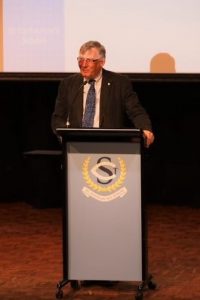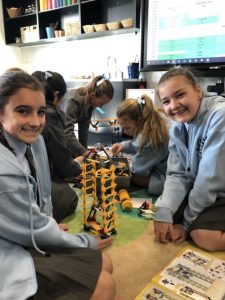From the Principal
“All scientists stand on the shoulders of those who go before them – so come join me and become one of them.” – Professor Paul Wood
National Science Week was celebrated in abundance this week at St Catherine’s School. Commencing on Monday, our annual Science Assembly address in the Senior School was delivered by Research Scientist, Professor Paul Wood. And in our Barbreck Assembly on Tuesday, guest speaker Stonnington Council Mayor, Cr Steve Stefanopoulos, recognised the School’s Environment Committee for their 2018 sustainability projects investigating energy usage in the new Barbreck building and the adequate disposal of waste.
During his address, Professor Paul Wood shared his own school experience in the 1970s and how he was inspired by an exceptional biology teacher, Brother Broderick, using the new curriculum text, The Web of Life. The curriculum was designed around a revolutionary idea of teaching science through experimentation. This practical approach to learning as a young student inspired Wood’s career choice of studying science. Some 15 years into his role as a research scientist at the Commonwealth Scientific and Industrial Research Organisation (CSIRO), he realised his very own experiment had discovered something new. His work at CSIRO had taken on a 100 year old challenge resulting in countless experiments to test his theories and, ultimately, he invented a new way to successfully diagnose tuberculosis.
Professor Wood is now internationally recognised for his research in veterinary immunology and research into tuberculosis. He spoke with pride of his very own contribution to the field of science. The development of the Tuberculous Kit some 27 years ago is still successfully used across the world today, providing a more effective and accurate diagnosis of tuberculosis. Professor Wood hopes that our very own St Catherine’s girls will also experience the joy of invention and he encouraged the girls of the positive prospects for women in science across Australia today.
Wood drew on the example of a number of successful female scientists paving their way in the field of science, both in Australia and globally. Most notably, the 2018 Australian of the Year, Professor Michelle Simmons, who is leading the world in quantum computing. Her team of research scientists were the first to develop a single atom transistor.
Dr Megan Clark, leading the Australian Space Agency and former Head of CSIRO, is hoping to leap-frog large overseas space agencies with her work at South Australian based satellite communications company, Myriota. This team of scientists are building nanosatellites (the size of your hand) that will be launched into orbit to collect data which could then be sent to farmers to improve the management of farms.
Professor Anne Kelso AO, leading the National Health and Medical Research Council, successfully manages the new $20 billion Medical Research Future Fund. Her work focuses on the development of DNA genome sequencing, enabling the improved understanding of the susceptibility to disease and response to current medicines.
And finally, Professor Rebecca Johnson, Director of the Australian Museum Research Institute, leads a team that have just completed the genome sequencing of the koala. This research will improve their conservation by understanding the impact of disease on this unique breed of Australian animal.
Professor Wood highlighted the indicators, revealing the jobs for the future will increasingly draw on a range of science, technology, engineering and mathematics (STEM) skills and knowledge. Ensuring young women are ‘in the game’ for such career paths remains the focus of girls’ schools across Australia and the increased availability of tertiary scholarships designed to attract female school graduates into the fields of engineering, science and technology.
In 2016, a report from the Office of the Chief Scientist, Busting Myths About Women in STEM, looked at research and data in the area of women and girls’ engagement in science and found “the attrition of female talent from STEM related fields actually commenced in primary school, and continued through to high school, university and the workforce”.
The report highlighted the gender disparity of students’ confidence in maths in grade 4, with 42% of boys compared to 33% of girls revealing a significant difference at such a young age. Girls were also less likely to accurately assess their ability in STEM related subjects compared to boys, even when they shared the same skill level. The report suggested the first way to amend this problem was to eliminate bias and stereotyping. This includes exposing girls and boys to female role models at a younger age. Interestingly, research shows that most girls and boys still draw a man when asked to draw a picture of a scientist.
According to the report, the push to overcome barriers to women prospering in STEM in the workplace needs to begin at primary school. “The key finding is we (Australia) are losing female talent right across the STEM pipeline despite the fact there is no innate difference in ability,” said Roslyn Prinsley, co-author of the report.
It is our intention to inspire budding scientists from the early primary years, enabling their confidence and abilities across STEM subjects to grow. With the addition of the STEM Lab and recruiting a science specialist teacher in the new Junior School, we hope to inspire and equip students from a young age with the confidence and capacity for our students to aspire to careers in the science industry.
In our Senior School, proposed changes to the curriculum offering in Year 10 also enables girls to select Chemistry, Biology, Physics and Psychology as specialist fields of study, instead of a general science program. This change will provide upwards of a 25% increase in learning time and an improved transition into the VCE Science programs. The refurbishment of laboratories in the Edna Holmes Centre for Science, completed over the mid-year break, have also ensured the learning spaces are fabulously engaging spaces to learn and study science.
Save the Date
Members of the School community and Senior School students are invited to attend one of SCOGA’s key events for the year. The 2018 Women in Industry Networking Event is an opportunity for you to hear from Old Girls and current parents who are leaders in their field and participate in open Q&A sessions covering:
- Law
- Medicine & Allied Health
- Marketing & Communications
- Creative Industries
- Banking & Financial Services
- Business Owners & Entrepreneurs
- STEM (Science, Technology, Engineering & Maths)
Wednesday 5 September 2018, 6.30pm – 9.30pm at St Catherine’s School





